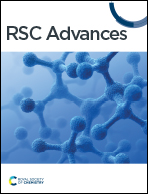Cardiac glycosides from Digitalis lanata and their cytotoxic activities†
Abstract
Cardiac glycosides (CGs) are good candidates as drug leads in the treatment of cancer because of their structural diversities and potent biological activities. In this study, fifteen CGs including three new ones (1–3) were isolated from Digitalis lanata Ehrh. Their structures were elucidated by HRESIMS, NMR spectroscopic methods, including homonuclear and heteronuclear coupling constant analysis, and acid-catalyzed hydrolysis and derivatization analysis of the sugar chain. The cytotoxic activities of these CGs were evaluated against three human cancer cell lines (A549, HeLa and MCF-7 cell lines), and all of them showed strong activities at nanomolar scale. The flow cytometric analysis indicated that compound 1 induced cell cycle arrest in the G2/M phase. Transcriptome analysis revealed a panel of possible targets for compound 1. RT-PCR and western blot experiments showed that 1 significantly inhibited the expression of vasohibin-2 (VASH2). Moreover, compound 1 restrained angiogenesis in a concentration-dependent manner in the chick embryo chorioallantoic membrane (CAM) model.



 Please wait while we load your content...
Please wait while we load your content...